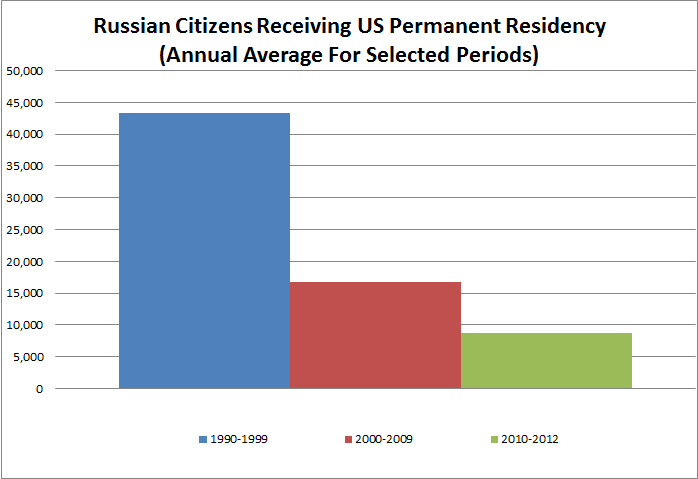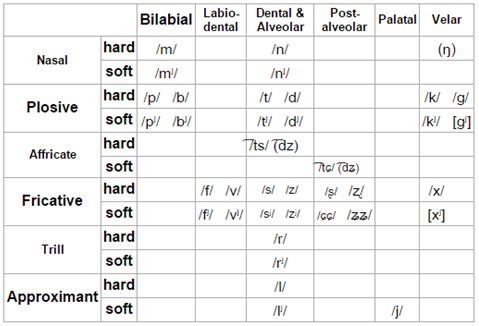Survey and Statistics
Russian American population mainly includes people who came from Russia to the US, but the term also may refer to other immigrants who used to live in the territory of the Soviet Union.
According to Census 2000, the Russian-speaking population is distributed in such a way:
- “NY Tri-State Area – 24%
- California – 16%
- Illinois – 16%
- Pennsylvania – 10%
- Massachusetts – 8%
- Florida – 7%
- DC and Maryland – 3%” (“Russian American Demographics” par. 4).
Today there are more than 600,000 individuals who speak Russian in Southern California while about 6 million are Russian-speaking in the whole US The community is mainly concentrated in “Hidden Hills, Calabasas, Los Angeles, Westlake Village, Agoura Hills, and Simi Valley, in declining order of affluence” (“Russian American Demographics” par. 4).
Not all Russian Americans know their origin language, as some of them were born in the US. However, the community encourages studying it. They have a website that is made for Russians who live in California, where people can communicate in both English and Russian. They have an opportunity to find a Russian-speaking job. There are shops with Russian products and media. Children can attend kindergartens with Russian as the main language (Personal communication).
History of Immigration
Immigration to America started in the 17th century due to trade connections. Then being a part of the Russian Empire, Alaska joined the US under the Russian-America Company at the end of the 19th century, and the majority of the population moved to Russia, but some people left. Searching for a better climate, many moved to California and settled there.
At that time, a vast amount of the population moved to the US, as the serfs gained freedom. Cholera epidemics and the riots that entailed it, violence towards the Jewish population faced in Russia at the end of the 19th century, and famine provoked other waves of immigration as well as the industrialization of America and the adoption of new laws.
During the 20th century, many Russians also moved to the US, as they wanted to avoid living in a period of economic depression. Of course, nowadays, people from Russia also come to America, as they believe the country to be more developed and think that they can get more opportunities when living in it.
The influence of globalization also cannot be denied, as many people come to receive education and stay in the US, and some change their location because of work (“Russian Immigration to America” par. 18). Still, the majority of Russians came to America before the 20th century, as people wanted to escape hunger, illnesses, and poverty.

Linguistic Features
The Russian language is one of the representatives of the Indo-European family of languages. It belongs to “the East Slavic branch of the Slavic subfamily of languages” (“A Guide to Russian” par. 6). Its cognate languages are Ukrainian and Belarusian. Being the closest relatives, they seem to be so alike that the population of these countries can understand each other on a basic level without any additional learning. It is much easier to speak Slavic languages for people who know Russian, as they have the same origin and lots of familiarities.
The word order in the language is determined by “the discourse structure of sentences” (Kallestinova 10). It means that there are no rules that are to be obligatory followed to build the sentence, but mainly the words are organized in SVO (subject-verb-object) order. Such types of orders as VSO, VOS, and OSV are also understood and sometimes used, but considered old-fashioned and/or strange.
For example, the sentence “Борис увидел Ивана” (Boris saw Ivan) can be written in this way and as “Ивана увидел Борис” (Ivan-Acc. saw Boris-Nom. = Ivan was seen by Boris). The sentence “Masha eats carrots seldom” can also be produced as “Carrots-Acc. Masha-Nom. Eats seldom”, “Masha eats carrots seldom,” “Masha seldom eats carrots,” “Seldom eats Masha carrots,” etc. Thus, the word order is flexible. Mainly, the relations between the words are showed by dint of flexion, which is not peculiar to English.
There are five/six (some scientists consider “ы” [ɨ] to be an allophone) vowel phonemes in the Russian language:

The phonemes are presented by ten letters, as some of them reflect the combination of two sounds (diphthongs). For example, “ю” is the connection of “j” and “u,” “я” of “j” and “a.” Vowel allophony depends on “stress and the palatalization of neighboring consonants” (Casiraghi and Jones par. 3).
There are 37 consonant phonemes (21 letters) that mainly come in pairs (soft and hard), which can be seen in the next table:

The syllable occurs due to the appearance of the vowel. It is basically built by joining consonants to the vowel regardless of their pre- or postposition. In other words, the syllables can have both initial and final consonants. The clusters can be even of four consonants (взгляд – vzglad = a look, glance). Still, one vowel can also represent a syllable (лек-ци-я – lek-tsi-a = lecture).
Like all languages, Russian has many borrowings and international words. Some of them resemble English ones in their spelling and pronunciation. For example, the word “флэш-карта” (flesh-carta) is one of the recent borrowings. It means “flashcard” and sounds similar. Such international words as “проблема” (problema) and “кофе”(cofe) can also be recognized by English-speaking population, as they refer to “problem” and “coffee” and sound alike.
There are words that may be confused by Americans. For instance, “магазин” (magazin), which sounds almost as “magazine,” means “shop.” Moreover, “you” can be translated in two ways. When people want to be polite, they say “вы” (vy) while “ты” (ty) is used in informal speaking. Russian has double negation, which is not peculiar to English. For example, “здесь никого нет” (there is no one here) means “there is no one here” (“A Guide to Russian” par. 10).
Language Use and Language Maintenance
Russian is widely used by the representatives of the community in Southern California. They usually speak Russian being at home or spending free time with their Russian-speaking friends and relatives. The Russian language is also used when communicating online and in some workplaces. Children have an opportunity to study Russian if the parents believe it is necessary.
Still, many individuals whose families immigrated to America long ago do not know Russian and speak only English. The young generations whose families do not speak English at home (or only one parent knows Russian) refer to Russian rarely. For them, it is a way to please their grandparents, who did not immigrate. Those who came to the US recently always use Russian except for the situations when they need to communicate with Americans.
The younger generations can watch Russian videos, read in Russian, and even study using this language. They do not frequently use it in the modern-day pop culture of Southern California but take part in puppet shows, concerts, etc.
Russian is taught in the US in many states, including California. Mainly it can be found in the universities, but there is also a college, a university preparatory school, and a school of arts. Preschool facilities allow little children to communicate in Russian also. There are several Russian Schools also, which proves that the community wishes their children to know Russian. They hire teachers and work with children in Russian themselves. Russian is also taught at some language courses that are available for individuals of different ages.
Russian is spread in media. It can be heard on the online radio (VolnaFM) and seen on such websites as ROSTOC.us and ruscalifornia.com; there is online Russian TV and magazine (MagazineFACT.com). They provide the information that is of advantage for immigrants, as it allows them to get in touch, find available services, etc. Some documents are available in Russian. For example, a DMV handbook can be found in eleven languages, including this one.
English-Russian code-switching is mainly seen when people from the community interact with one another, and then an English-speaking person enters a conversation. The language may be not changed outdoors when people do not want to attract attention. Mainly the population does not consider it to be a problem, but they mentioned that it leads to code-mixing, which makes the interaction more complicated.
The majority have a positive attitude towards their native language, as they believe it to link it with their own country. Still, a part of the younger generation believe that there is no sense in learning and using Russian, as they are not going to return to Russia. Moreover, Russian tends to be used less nowadays because the majority of the immigrants came in the 19th century, and their families got used to English (Personal communication).
Works Cited
Adomanis, Mark. Russian Emigration to the United States Is a Lot Lower than It Was in the 1990’s or 2000’s. Web.
A Guide to Russian. 2014. Web.
Casiraghi, Roberto, and Crystal Jones. Russian Phonology. n.d. Web.
Kallestinova, Elena. Aspects of Word Order in Russian 2007. Web.
Russian American Demographics. 2000. Web.
Russian Immigration to America. 2015. Web.